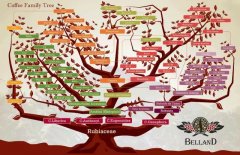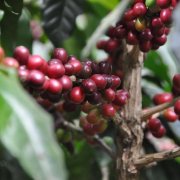Taste characteristics of Colombian Coffee Bean producing areas and their relationship between Coffee Flavor and growing Environment
How many coffee growing areas are there in Colombia?
Sour Colombian coffee that makes you comfortable, good coffee will make you feel that the sweet and sour taste of the entrance is easy to accept. Colombian coffee starts with the first taste of caramel, and as the temperature drops, the nutty flavor will gradually appear. The whole coffee makes people feel very comfortable. More suitable for the taste of the public, Colombian coffee is also very widely used, can be used as a combination of beans, can also be used as a pure thickness of the French kettle, or hand flushing is OK. Different producing areas will have different flavors. Today, let's take a look at the coffee producing areas in Colombia.
Colombia has five major coffee-growing areas and 19 subregions.
North
Departments: Santander, Magdalena, Cesar
Facts about the area:
Santander-Coffee is thought to have reached Colombia through Santander. Coffee usually tastes of chocolate.
Sierra Nevada-usually chocolate-flavored nuts, there are many indigenous groups in the area that use natural organic methods. Coffee with low acidity but high concentration.
Central North and Central South
Provinces: Antioquia, Caldas, Choco, Rizalda, Kindio, Cundinamarca and northern Tolima.
The difference between coffee: it's hard to summarize such a large area, but coffee here tends to produce a typical Colombian coffee flavor-sweet coffee with a hint of brown sugar (raw sugar or caramel) and a medium to high body.
Facts about the region: Antioquia is the second largest producing area in Colombia and Tolima is the third largest.
South
Departments: Cauca, Wirat and Narinho.
Why is coffee different?
The area is close to the equator, so coffee grows at lower temperatures at higher elevations. A drop in temperature at night, associated with a relatively high altitude, slows down the ripening of coffee beans. This helps to develop sugar in beans and give them higher acidity.
This is an area particularly related to quality, producing higher-quality coffee known for its impressive acidity.
Facts about this area
Cauca has indigenous communities and African Colombian communities that use traditional coffee processing methods. There is also a lot of fertile volcanic soil, and coffee has a fruity and sweet taste.
Wirat is an important coffee producing area in terms of yield and quality. People are looking for quality boutique coffee in this area, and many growers have won local and national competitions. Huila was named of origin in 2013. (appellation of origin is a legal name that can guarantee the authenticity of the customer's products. DO Coffee meets the process and quality requirements associated with the name.
Nari ñ o is on the equator, so the way the sun shines on the mountains creates a more acidic, aromatic coffee.
Oriental
Departments: Arauca, Casanare, Meta and Caquet á.
Facts about the region: only 5500 producers grow coffee on about 10500 hectares of land. Many of these producers have been hit hard by internal conflicts.
Why coffee is different: in general, the climate and coffee results are similar to those in the north.
Important Notice :
前街咖啡 FrontStreet Coffee has moved to new addredd:
FrontStreet Coffee Address: 315,Donghua East Road,GuangZhou
Tel:020 38364473
- Prev

Brief introduction of Arabica interspecies hybrid coffee bean flavor characteristics of new variety Ruilu 11 Carmont
What is a Cameroun hybrid coffee? What is Arabusta coffee? How did these interspecific hybrid coffee beans develop? Is there any difference between flavor and taste and traditional beans? With these questions, let's explore Arabica's interspecific hybrid series of beans. Mixed-race series: Arabica with non-Arabica and non-Arabica
- Next

What are the most expensive coffee beans in the world? The story behind the high price and the characteristics of flavor and taste
There are many kinds of coffee in the world, but do you know which coffee is the most expensive? What's so special about them that makes them so expensive? What are their unique flavors? Let's let the editor give you a brief introduction. 1. Indonesian muskfish, $160 per pound. Why is his price so high? Mainly because of its processing. Musk cat
Related
- Detailed explanation of Jadeite planting Land in Panamanian Jadeite Manor introduction to the grading system of Jadeite competitive bidding, Red bid, Green bid and Rose Summer
- Story of Coffee planting in Brenka region of Costa Rica Stonehenge Manor anaerobic heavy honey treatment of flavor mouth
- What's on the barrel of Blue Mountain Coffee beans?
- Can American coffee also pull flowers? How to use hot American style to pull out a good-looking pattern?
- Can you make a cold extract with coffee beans? What is the right proportion for cold-extracted coffee formula?
- Indonesian PWN Gold Mandrine Coffee Origin Features Flavor How to Chong? Mandolin coffee is American.
- A brief introduction to the flavor characteristics of Brazilian yellow bourbon coffee beans
- What is the effect of different water quality on the flavor of cold-extracted coffee? What kind of water is best for brewing coffee?
- Why do you think of Rose Summer whenever you mention Panamanian coffee?
- Introduction to the characteristics of authentic blue mountain coffee bean producing areas? What is the CIB Coffee Authority in Jamaica?

